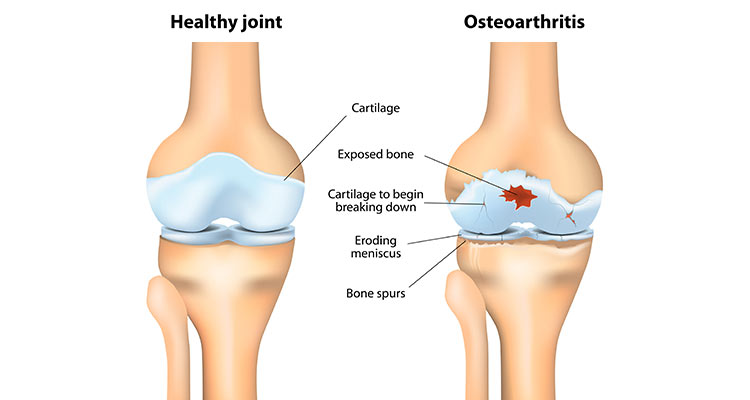Osteoarthritis results from the breakdown of cartilage in the joints and is a type of arthritis that occurs when flexible tissue at the ends of bones wears down.
In the joints, a protective layer of cartilage covers the ends of the bones where they meet. Osteoarthritis develops when cartilage deteriorates. Over time this leads to painful friction and joint damage. It is most often found in the hips, knees, ankles, shoulders, and writs, and in the fingers and base of the thumb.
The first signs of Osteoarthritis are microscopic pits and cracks in the cartilage. The cartilage thins, and tiny pieces may flake off. The rough, altered surfaces move against each other, causing further damage.
Over time, exposed patches of bone start to run against one another, creating friction and irritation. They try to repair themselves. Bony lumps called Osteophytes may form as a result. All of these abnormalities can also irritate the soft tissues surrounding the tissue.
Symptoms of Osteoarthritis
Osteoarthritis usually affects multiple joints in the body. People who have Osteoarthritis often complain of a deep ache centered in the joint. Typically, moving the joint causes pain, and resting the joint brings relief. As the disease worsens, the pain becomes constant. Some symptoms include:
- Joint stiffness and limited flexibility, especially after staying in one position for too long
- Joint pain, with or without swelling
- Grinding sensation when joints are moved
- Numbness or tingling in an arm or leg, if changes in the spine result in a pinched nerve
- Bony lumps at the ends of fingers or on the middle joints of fingers
Diagnosis of Osteoarthritis
In order to diagnose osteoarthritis, a thorough physical examination is performed to evaluate pain level, muscle weakness, range of motion, and any possible involvement of other joints. A complete medical history that assesses family history and past injuries is taken. If the physical examination indicates osteoarthritis, other diagnostic tests may be performed, including:
- X-rays
- MRI scan
- Blood tests to screen for other diseases
- Analysis of fluid that lubricates the joint
Treatment of Osteoarthritis
Medical treatments can relieve pain, increase range of motion, and keep you active. No drug can cure or reverse Osteoarthritis, but medications can improve your quality of life. Below are a few treatments:
- Topical pain relievers
- Acetaminophen
- Nonsteroidal anti-inflammatory drugs (NSAIDs)
- Corticosteroid injections
- Hyaluronate
- Joint replacement surgery
Prevention of Osteoarthritis
Improper use of arthritic joints can lead to pain, swelling, and more join damage. Staying active and keeping your muscles strong helps protect your joints. but it’s important to limit any joint motion that causes pain and stiffness. Below are some prevention methods:
- Avoid holding one position for too long
- Use your strongest joints and muscles
- Use labor-saving items and adaptive aids
Need Help Affording Medications?
Patients who are having difficulty paying for their medications, and who have federally funded Medicare, Medicaid, TRICARE, or commercial insurance, may qualify for additional support from the following foundations below:
- Chronic Disease Fund | www.cdfund.org | 877-968-7233
- Patient Access Network Foundation | www.panfoundation.org | 866-316-7263
- The Healthwell Foundation | www.healthwellfoundation.org | 800-675-8416
- Patient Advocate Foundation | www.copays.org | 866-512-3861




